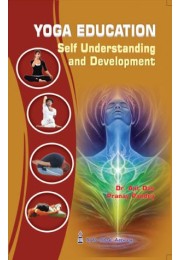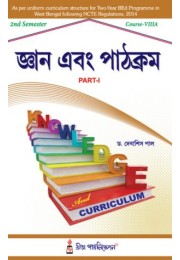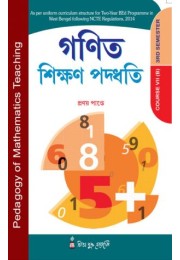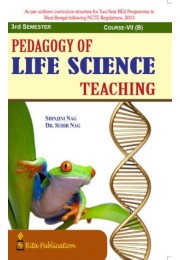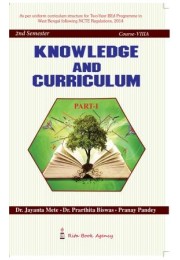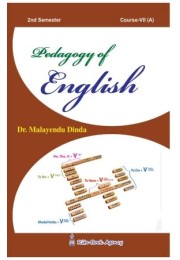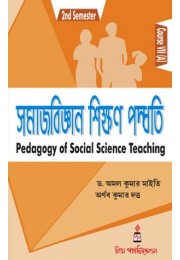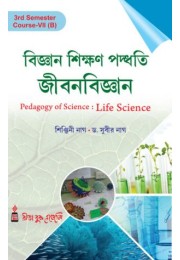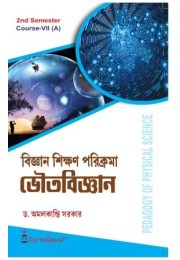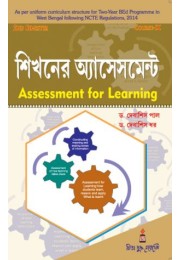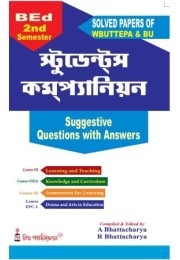Childhood and Growing up
Rs.209.00Rs.220.00
Author: Dr. Subir Nag
Availability: In Stock
Publisher: Rita Publication

1. Growth and Development Pattern of Learners 1-56
1.1. Concept of Growth and Development 3
1.1.1. Concept and Meaning of Growth 3
1.1.2. Concept and Meaning of Development 4
1.1.3. Various Perspective of Growth and Development 5
1.1.4. Influence of Nature and Nurture on Growth and Development 8
1.1.5. Approaches to Study Growth and Development 8
1.1.6. Factors affecting Human Development 9
1.2. General Characteristics of Growth and Development 11
1.2.1. Characteristics of Growth 11
1.2.2. Characteristics of Development 12
1.2.3. Principles of Development 12
1.2.4. Relationship between Growth and Development 15
1.2.5. Differences between Growth and Development: 15
1.3. Stages and Sequence of Growth and Development 17
1.3.1. Stages and Sequences of Development 21
1.4. Social Factors that affect Growth and Development— Poverty, Lack of Opportunities, Deprivation, Disrupted Family, Poor Neighbourhood, Poor housing 34
1.4.1. Poverty 34
1.4.1.1. Meaning of Poverty 34
1.4.1.2. Definition of Poverty 35
1.4.1.3. Types of Poverty in India 35
1.4.1.4. Causes of Poverty in India 36
1.4.1.5. Effects of Poverty in India 37
1.4.1.6. Measures for liquidation of Poverty 38
1.4.2. Lack of Opportunities 40
1.4.2.1. Meaning of Unemployment 40
1.4.2.2. Definition of Unemployment 40
1.4.2.3. Types of Unemployment 41
1.4.2.4. Causes of Unemployment 44
1.4.2.5. Effects of Unemployment 45
1.4.2.6. Solutions to the Unemployment 46
1.4.3. Deprivation 47
1.4.4. Disrupted Family 51
1.4.5. Poor Neighbourhood 54
1.4.6. Poor Housing 55
2. Stages of Development 57-92
2.1. Different Stages of Development: Infancy, Childhood, Adolescence, Adulthood 5
2.1.1. Overview of Developmental Stages 58
2.1.2. Summary of Stages of Development 72
2.2. Adolescence: Physical Development, Emotional Development, Cognitive Development 72
2.2.1. Concept of Adolescence 72
2.2.2. Developmental Tasks during Adolescence 73
2.2.3. Characteristics of Adolescence 74
2.2.4. Significance of Adolescence Stage 77
2.2.5. Role of Parents and Teachers towards Adolescents 78
2.2.6 Physical Development, Cognitive Development and Emotional Development during Adolescents 80
2.3. Needs and Problems of Adolescents and their Guidance and Counselling 83
2.3.1. Basic Needs of Adolescents 83
2.3.2. Problems in Adolescents 85
2.3.3. Guidance and Counselling Programmes for Adolescent Students 88
3. Different Types of Development 93-156
3.1. Cognitive Development: Piaget’s Theory and its Educational Implications 93
3.1.1. Basic Cognitive Concepts 94
3.1.2. Piaget’s Stages to Cognitive Development 94
3.1.3. Piaget’s stages of Cognitive Development Chart 99
3.1.4. Educational Implications of Different Stages of Cognitive Development 100
3.1.5. Stages of Moral Development as Proposed by Piaget 102
3.2. Psycho-Sexual Development: Freud’s Theory 103
3.2.1. Development of Conscious, Sub-conscious or Pre- conscious and Unconscious Minds 104
3.2.2. Structural Model of Personality 105
3.2.3. Psycho-Sexual Development Theory 106
3.2.4. Concept of Libido 111
3.2.5. Educational Implications of Psychosexual Development 113
3.2.6. Criticism of Freud’s Psychosexual Development Theory 115
3.3. Psycho-Social Development: Erikson’s Theory of Psycho-Social Development 115
3.3.1. Psycho-Social Development Theory 116
3.3.2. Erikson’s Major Role in developing Psycho-social Development Theory 120
3.3.3. Approaches of Psycho-social Development Theory 120
3.3.4. Educational Implications of Psycho-social Development 121
3.3.5. Criticism of Psycho-social Development 122
3.4. Moral and Pro-Social Development: Kohlberg’s Theory 124
3.4.1. Kohlberg’s Theory of Moral Development 126
3.4.2. Observations made by Kohlberg Explaining Human Development 128
3.4.3. Educational Implications of Moral Development Theory 130
3.4.4. Criticism of Moral Development Theory 130
3.5. Development of Self-Concept and Personal Identity 131
3.5.1. Definition of Self Concept 133
3.5.2. Importance of Self Concept 134
3.5.3. Components of Self Concept 135
3.5.4. Factors influencing Self Concept 135
3.5.5. Development of Self Concept 137
3.5.5.1. Development of Self Concept according to Erikson’s Theory 138
3.5.5.2. Factors influencing in the development of Self Concept 140
3.5.5.3. Strategies taken for the development of Self Concept 141
3.5.6. Impact of Positive and Negative Self Concept 142
3.5.7. Theory of Self Concept 143
3.5.8. Educational Implications of Self Concept Theory 145
3.6. Communication and Speech Development: Para-Linguistic and Linguistic Stages of
Development 146
3.6.1. Language Development 146
3.6.2. Components of Language Development 146
3.6.3. Phases of Language Development 147
3.6.4. Stages of Language Development 152
3.6.5. Role of Teacher Regarding Language Development 154
4. Individual Differences 157-192
4.1. Concept of Individual Difference 157
4.1.1. Definition of Individual Difference 159
4.1.2. Nature of Individual Differences 160
4.1.3. Causes of Individual Differences 160
4.1.4. Types of Individual Differences 162
4.1.5. Strategies for Handling Individual Differences among Students 163
4.1.6. Provisions for ‘Individual Differences’ in Schools 164
4.1.7. Educational Implications of Individual Differences 166
4.2. Role of Heredity, Environment Including Physical and Socio-Cultural Factors 167
4.2.1. Role of Heredity 167
4.2.2. Role of Environment 169
4.3. Nutrition 173
4.3.1. Various types of Nutrient-dense foods 173
4.3.2. Types of Nutrition 174
4.3.3. Importance of Nutrition 174
4.3.4. Deficiency Symptoms and Signs 175
4.3.5. Material Nutrition 178
4.4. Child Rearing Practices and Family 180
4.4.1. Meaning of Child rearing Practices 181
4.4.2. Aspects of Child-rearing Practices 182
4.4.3. Salient Features of Traditional Indian Child Rearing Practices 183
4.4.4. Important things about children’s Happiness 184
4.4.5. Theories of Child Rearing Practice 187
4.4.6. Family Environment and Its Importance in Child Rearing Practice 188
5. Development of Personality 193-224
5.1. Concept, Types and Traits of Personality 193
5.1.1. Definition of Personality 194
5.1.2. Nature of Personality 195
5.1.3. Determinants of Personality 196
5.1.4. Different views about Personality 199
5.1.5. Different Perspectives of Personality 199
5.1.6. Characteristics of Personality 200
5.1.7. Types of Personality 201
5.1.7.1. Hippocrate’s Typology 201
5.1.7.2. Kretschmer’s Typology 202
5.1.7.3. Sheldon’s Typology 202
5.1.7.4. Jung’s Typology 203
5.1.7.5. Spranger’s Typology 204
5.1.8. Traits of Personality 205
5.1.8.1. Properties of Traits 205
5.1.8.2 Characteristics of Traits 205
5.1.8.3. Types of Traits 206
5.1.9. Theories of Personality 206
5.2. Trait Theories (Eysenck and Cattell’s 16 Factors, Five Factor Model) 207
5.2.1. Eysenck’s Theory of Personality 208
5.2.2. Allport’s Theory of Personality 210
5.2.3 Cattell’s Theory of Personality 212
5.2.4. Five Factor Model of Personality (FFM) 214
5.3. Measurement of Personality (Self-Report and Projective Techniques) 216
5.3.1. Self-Reporting Methods 217
5.3.1.1. Minnesota Multi Phasic Personality Inventory (MMPI) 217
5.3.1.2. Millon Clinical Multiaxial Inventory (MCMI) 218
5.3.1.3. NEO- Personality Inventory (NEO-PI) 218
5.3.1.4. Bell Adjustment Inventory (BAI) 219
5.3.1.5. California Psychological Inventory (CPI) 219
5.3.2. Observational Methods 220
5.3.3. Projective Techniques 220
5.3.3.1. Types of Projective Techniques 221
5.3.3.2. Some important Projective Techniques 222
2nd Half
1. Various Aspects Related to Development 226-277
1.1. Concept, Nature, Interrelationship and Educational Implication of Instincts and Emotions 226
1.1.1. Concept, Nature and Educational Implication of Instincts 226
1.1.1.1. Definition of Instinct 227
1.1.1.2. Nature of Instinct 228
1.1.1.3. Characteristics of Instinct 228
1.1.1.4. Educational Implication of Instinct 229
1.1.2. Concept, Nature and Educational Implication of Emotion 230
1.1.2.1. Definition of Emotion 230
1.1.2.2. Aspects of Emotion 231
1.1.2.3. Characteristics of Emotions 231
1.1.2.4. Dimensions and Development of Emotions 232
1.1.2.5. Functioning of Emotions in Life 233
1.1.2.6. Relationship between Motivation and Emotion 234
1.1.2.7. Emotion and Physiology 234
1.1.2.8. Major Types of Emotions 235
1.1.2.9. Role of Emotion on Education 237
1.1.2.10. Educational Implication of Instinct 237
1.1.3. Interrelationship between Instincts and Emotions 239
1.2. Concept, Nature, and Educational Implication of Emotional Intelligence 239
1.2.1. Meaning and Concept of Emotional Intelligence 240
1.2.2. History of Emotional Intelligence 243
1.2.3. Definition of Emotional Intelligence 245
1.2.4. Nature of Emotional Intelligence 246
1.2.5. Bases of Emotional Intelligence 247
1.2.6. Factors affecting Emotional Intelligence 248
1.2.7. Various Model of Emotional Intelligence 249
1.2.7.1. Ability Model of Emotional Intelligence 249
1.2.7.2. Bar-On Mixed Model of Emotional Intelligence 251
1.2.7.3. Goleman Mixed Model of Emotional Intelligence 252
1.2.8. Applications of Emotional Intelligence 253
1.2.9. Emotional Intelligence in Indian Context 254
1.2.10. Components of Emotional Intelligence 256
1.2.11. Advantages of Emotional Intelligence 259
1.2.12. Educational Implication of Emotional Intelligence 260
1.3. Concept, Nature and Educational Implication of Attitude and Attachment 262
1.3.1. Concept, Nature and Educational Implication of Attitude 262
1.3.1.1. Definition of Attitude 263
1.3.1.2. Nature of Attitude 264
1.3.1.3. Characteristics of Attitude 264
1.3.1.4. Functions of Attitude 265
1.3.1.5. Classification of Attitude 265
1.3.1.6. Process of Formation of Attitude 267
1.3.1.7. Relationship between Attitude and Behaviour 267
1.3.1.8. Components of Attitudes 268
1.3.1.9. Factors Responsible for Development of Attitudes 269
1.3.1.10. Educational Implication of Attitude 270
1.3.2. Concept, Nature and Educational Implication of Attachment 271
1.3.2.1. Definition of Attachment 272
1.3.2.2. Nature of Attachment 272
1.3.2.3. Types of Attachment 273
1.3.2.4. Development of Attachment 274
1.3.2.5. Educational Implication of Attachment 275
2. Motivation 278-314
2.1. Extrinsic and Intrinsic Motivation 279
2.1.1. Meaning of Motivation 279
2.1.2. Definition of Motivation 279
2.1.3. Nature of Motivation 281
2.1.4. Features or Characteristics of Motivation 282
2.1.5. Principles of Motivation 282
2.1.6. Key Concepts of Motivation 283
2.1.7. Types of Motivation 286
2.1.8. Implication of Motivation in Classroom Situation 289
2.1.9. Importance of Motivation 289
2.1.10. Advantages of Motivation 290
2.1.11. Difference between Motivation, Satisfaction, Inspiration and Manipulation 291
2.2. Theories of Motivation—Maslow, Weiner and McClelland 292
2.2.1. Maslow’s Hierarchy of Needs 292
2.2.2. Weiner’s Theory of Motivation or Attribution Theory of Motivation 297
2.2.3. McClelland’s Achievement Motivation Theory 300
2.3. Factors affecting Motivation—Self-Efficacy, Locus of Control, Anxiety, Curiosity and
their Classroom Implications 305
2.3.1. Self-Efficacy 305
2.3.2. Locus of Control 307
2.3.3. Anxiety 310
2.3.4. Curiosity 312
3. Attention and Interest 315-333
3.1. Concept, Determinants of Attention and their Classroom Application 315
3.1.1. Definition of Attention 316
3.1.2. Nature of Attention 316
3.1.3. Feature or Characteristics of Attention 318
3.1.4. Types of Attention 318
3.1.5. Functions of Attention 319
3.1.6. Factors or Determinants of Attention 321
3.1.7. Educational Implication or Classroom Application of Attention 323
3.2. Attention Span and its Fluctuation, Distraction 324
3.2.1. Span of Attention 324
3.2.2. Fluctuation of Attention 324
3.2.3. Distraction of Attention 325
3.2.4. Role of attention in cognitive process 325
3.3. Interest and its relation with Attention 326
3.3.1. Concept of Interest 326
3.3.2. Definition of Interest 327
3.3.3. Nature of Interest 327
3.3.4. Feature or Characteristics of Interest 327
3.3.5. Types of Interest 328
3.3.6. Relationship between Interest and Attention 328
3.3.7. Educational Implication of Interest 330
3.3.8. Measurement of Interest 332
4. Intelligence 334-377
4.1. Concept and Nature, its distribution across Population 335
4.1.1. Theoretical Background of Intelligence 336
4.1.2. Definition of Intelligence 337
4.1.3. Nature of Intelligence 338
4.1.4. Features or Characteristics of Intelligence 339
4.1.5. Types of intelligence 339
4.1.6. Role of Heredity and Environment as deter-minants of Intelligence 340
4.1.7. Development of Intelligence 341
4.2. Factor Theories of Intelligence (Guilford, Thurston and Gardner’s Theory of Multiple Intelligence) 341
4.2.1. Unitary or Monarchy Theory of Intelligence 342
4.2.2. Spearman’s Two-Factor Theory of Intelligence 342
4.2.3. Thorndike’s Multi-Factor Theory of Intelligence 343
4.2.4. Thurstone’s Group-Factor Theory of Intelligence 344
4.2.5. Howard Gardner’s Theory of Multiple Intelligence 346
4.2.6. Sternberg’s Triarchic Theory Of Intelligence 350
4.2.7. Guilford’s Structure of Intellects Theory of Intelligence 351
4.3. Measurement of intelligence (Verbal and Non-verbal Tests of Intelligence) 354
4.3.1. Definition of Intelligence Test 354
4.3.2. Purposes of Intelligence Test 354
4.3.3. Classification of Intelligence Tests 355
4.3.4. Uses of Intelligence Test 367
4.3.5. Advantages of Intelligence Tests 367
4.3.6. Limitations of Intelligence Test 268
4.3.7. Abilities measured by Intelligence Tests 368
4.3.8. Difference between Verbal Test and Non-verbal Test of Intelligence 369
4.3.9. Difference between Individual and Group Tests of Intelligence 369
4.4. Intelligence quotient and education 369
4.4.1. History of Intelligence Quotient (IQ) 371
4.4.2. Common tradition about Intelligence Quotient (IQ) 372
4.4.3. Trends in Intelligence Quotient (IQ) 372
4.4.4. Constancy of Intelligence Quotient (IQ) 373
4.4.5. Differentiating among Intelligence Quotient (IQ), Emotional Quotient (EQ) and Spiritual Quotient (SQ) 374
4.4.6. Education and its effect on Intelligence Quotient (IQ) 375
5. Creativity 378-405
5.1. Concept of Creativity 378
5.1.1. Definitions of Creativity 379
5.1.2. Nature of Creativity 380
5.1.3. Features or Characteristics of Creativity 381
5.1.4. Process of Creativity 382
5.1.5. Educational Implications of Creativity 382
5.1.6. Development of Creative Skills 384
5.1.7. Relationship of Creativity with other Variables 387
5.2. Components of Creativity 390
5.3. Identification and Nurturance of Creativity 299
5.3.1. Identification of Creativity 399
5.3.2. Fostering Creativity 401
5.3.3. Nurturance of Creativity 402
5.3.4. Conditions of Nurturing Creativity 403
5.3.5. Problems of Teachers in Nurturing Creativity during Elementary Stage 403


